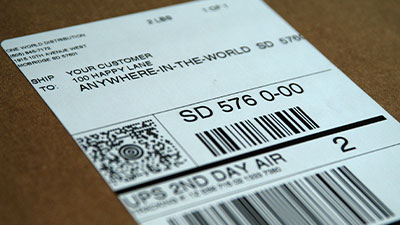Cross-border ecommerce connects brands and customers across international borders, enabling businesses to sell products worldwide. This global approach opens up new markets, boosts brand visibility, and increases revenue potential. According to industry reports, cross-border ecommerce is expected to surpass $7 trillion and account for 23.6% of all retail sales worldwide by 2025, with China’s cross-border ecommerce leading much of this growth.
Shoppers today expect fast delivery, clear communication, and even personalized touches, regardless of where they live. Brands looking to expand internationally need more than a warehouse; they require innovative cross-border ecommerce solutions and a strategy that balances efficiency with profit.
Explore strategies for efficient cross-border ecommerce fulfillment, including the latest trends, technology tips, working with a 3PL, and actionable steps any brand can use to succeed in international markets. Whether you’re selling monogrammed gifts or consumer electronics, mastering cross-border ecommerce strategy means building the right system for every customer, everywhere.
Understanding Cross-Border Ecommerce Fulfillment Challenges
Navigating cross-border ecommerce comes with its own set of challenges that can affect both brand reputation and profit margins. To keep international buyers satisfied and loyal, it’s crucial to tackle these issues.
Common Fulfillment Challenges:
Each country has its own rules regarding product entry, declaration processes, and applicable taxes or duties. Even minor errors in paperwork or product labeling can result in significant customs delays or additional fees.
International shipping can quickly eat into profit margins. Carriers charge higher rates for longer distances, heavier packages, and remote delivery locations. Fuel surcharges and handling fees also contribute to the overall cost.
When crossing borders, there are more handoffs between carriers, longer transit routes, and potential customs stops. Shoppers expect fast delivery even for international orders, so slow fulfillment can lead to abandoned carts and negative reviews.
Tariffs are additional fees imposed on imported products by the country of destination. These taxes can significantly increase the cost of goods and erode profit margins. Staying updated on tariff rates and regulations is essential to avoid unexpected expenses and maintain competitive pricing.
Effective communication with international customers is crucial for a seamless shopping experience. Language barriers can lead to misunderstandings, while cultural differences may require adjustments in marketing strategies or product offerings.
Dealing with returns from international customers can be complex and costly. Shipping fees, customs paperwork, and potential damage during transit all contribute to the challenges of cross-border return management. Additionally, providing customer support across different time zones can strain resources.
To overcome these challenges and optimize cross-border ecommerce fulfillment, businesses should consider partnering with experienced logistics providers that specialize in international shipping and have a deep understanding of customs regulations, local delivery networks, and customer preferences in various regions. By leveraging their expertise, brands can streamline operations, reduce costs, and ultimately deliver a superior experience to their global customer base.
Strategies for Overcoming Cross-Border Ecommerce Fulfillment Challenges
1. Implementing a Robust Order Management System (OMS)
Order Management System (OMS) Overview
An Order Management System (OMS) is crucial for streamlining cross-border ecommerce fulfillment. It integrates various processes, including order processing, inventory management, and shipping coordination, across multiple countries. This integration ensures a seamless flow from the moment an order is placed to the moment it reaches the customer.
Benefits of a Robust OMS
- Streamlined Order Processing: Automates order capturing from different sales channels, reducing manual entry errors.
- Improved Inventory Management: Provides real-time inventory updates across all locations, preventing stockouts and overselling.
- Efficient Shipping Coordination: Manages shipping logistics by selecting the best carrier and optimizing delivery routes.
Key Features to Look For in an OMS
When selecting an OMS for cross-border ecommerce, consider these essential features:
- Multi-Currency and Multi-Language Support: Ensures seamless transactions in multiple currencies and languages, enhancing the global customer experience.
- Automated Tax Calculation and Compliance: Automatically calculates taxes based on local regulations, ensuring compliance with international tax laws.
- Real-Time Inventory Tracking: Provides up-to-date inventory levels across multiple warehouses, helping businesses maintain optimal stock levels.
- Integration Capabilities: Seamlessly integrates with other systems such as CRM, ERP, and shipping carriers for a unified workflow.
- Customizable Reporting and Analytics: Offers detailed insights into sales performance, inventory turnover, and customer behavior.
Examples of Effective OMS Implementations
- Shopify Plus: Known for its robust multi-channel capabilities and real-time inventory tracking.
- NetSuite: Offers comprehensive tax calculation features and deep integration with financial systems.
- Brightpearl: Tailored for fast-growing retailers needing strong reporting tools and automation capabilities.
By implementing a robust OMS tailored to your business needs, you can address many of the operational challenges associated with cross-border ecommerce fulfillment. This not only improves efficiency but also enhances the overall customer experience by ensuring timely deliveries and accurate order fulfillment.
2. Offering Multiple Shipping Options to Customers
Customers demand flexible shipping options, especially for international orders. Providing multiple shipping options enables customers to choose the one that best suits their needs in terms of price, speed, and reliability. This can be achieved by integrating your OMS with various shipping carriers, allowing customers to select their preferred carrier and service level at checkout.
Moreover, offering a range of shipping options can help reduce cart abandonment rates. Research indicates that high shipping costs, followed by slow delivery, are the primary reasons for cart abandonment. By offering transparent and competitive shipping rates, you can boost conversion rates and customer loyalty.
Benefits of Providing Various Shipping Choices
Offering multiple shipping options is a key strategy for efficient cross-border ecommerce fulfillment. By catering to different customer preferences and budgets, businesses can:
- Increase Customer Satisfaction: Customers appreciate having choices between express delivery and economy shipping based on their urgency and budget.
- Boost Conversion Rates: Providing flexible shipping options can reduce cart abandonment rates, as customers are more likely to complete their purchase when they have control over delivery speed and cost.
Tips for Communicating Estimated Delivery Times
Effectively communicating estimated delivery times helps manage customer expectations. Here are some tips:
- Clear Information at Checkout: Display estimated delivery times for each shipping option during the checkout process.
- Real-Time Updates: Use automated systems to provide real-time updates on order status and expected delivery dates.
- Transparency: Clearly explain any potential delays due to customs or international regulations.
Collaborating with experienced logistics partners is essential for efficiently handling international shipments. Reliable providers can navigate customs processes and ensure timely deliveries.
3. Localizing Packaging and Documentation Requirements
Localization in cross-border ecommerce isn’t just about translating your website; it’s about tailoring every part of the fulfillment experience. Regulations and cultural preferences vary by country, making it essential to tailor packaging materials and customs documentation to each target market.
Regulatory Compliance
Many countries have strict rules regarding sustainable packaging, such as the requirement for recyclable materials in the EU or specific labeling in Canada. Customs documents must be completed accurately, or shipments may be delayed or even returned. An order management system for cross-border ecommerce can help automate this paperwork.
Cultural Expectations
Gift wrap, monogramming, and personalized touches are valued differently around the world. In Japan, for example, meticulous gift presentation is expected; in Germany, efficient but eco-friendly packaging wins trust.
Partnering with reliable 3PL is instrumental. These experts stay current on international requirements and help brands avoid costly mistakes.
Case Study
A U.S.-based cosmetics brand expanded into South Korea and worked with a logistics provider specializing in APAC fulfillment. By localizing product labels to comply with Korean regulations and redesigning their packaging, they reduced delivery times and return rates.
Strategies for efficient cross-border ecommerce fulfillment start at the box—knowing what goes inside, how it’s packed, and ensuring every document is ready for smooth customs clearance.
Leveraging Technology for Efficient Cross-Border Ecommerce Fulfillment
1. Using Automated Customs Clearance Software
Automated customs clearance software can significantly streamline the process of calculating duties and taxes, ensuring compliance with international regulations. By automating these procedures, businesses can reduce errors and expedite the clearance process.
Benefits of Automated Customs Clearance Software:
- Accurate Calculations: Automated systems analyze product classifications to determine precise duties and taxes.
- Speedy Processing: These tools expedite customs clearance, minimizing potential delays.
- Compliance Assurance: Ensures adherence to varying international regulations, minimizing the risk of fines or shipment holds.
Recommended Software Options:
- ClearDestination: Offers real-time duty and tax calculations, simplifying cross-border shipments.
- Easyship: Provides automated tariff and tax calculations along with multiple shipping options.
- Zonos: Specializes in calculating total landed costs, including duties, taxes, and shipping fees.
Utilizing automated customs clearance software is crucial for enhancing accuracy in duty calculations and expediting the overall shipping process.
2. Implementing Real-Time Shipment Tracking Systems
Benefits of Providing Real-Time Visibility
- Enhanced Customer Satisfaction: Customers appreciate knowing the current status of their orders at any given time, which increases trust and satisfaction. 43% of consumers check their tracked orders every day until delivery, so implementing these transparent tracking systems is imperative.
43%
of consumers check their tracked orders every day until delivery
- Reduced Customer Inquiries: Providing real-time tracking information reduces the number of customer service inquiries about order status. Brands receive an average of 882 monthly customer support tickets, and implementing accurate and proactive order updates can significantly reduce shopper inquiries.
- Proactive Issue Resolution: Real-time tracking allows businesses to identify and address potential delivery issues before they escalate.
Technologies Enabling Effective Shipment Tracking Across Borders
- GPS and RFID Technology: These technologies provide precise location data, enabling the monitoring of shipments throughout their journey.
- API Integrations: Integrating tracking systems with ecommerce platforms ensures seamless data flow and updated information for customers.
- Mobile Apps: Custom mobile applications can provide real-time updates directly to customers’ smartphones, thereby enhancing their overall experience.
Implementing real-time shipment tracking is essential for efficient cross-border ecommerce fulfillment. It not only boosts customer satisfaction but also optimizes internal processes by allowing proactive management of potential delivery issues.
3. Adopting Cloud-Based Inventory Management Tools
Cloud-based inventory management tools for cross-border ecommerce are changing the game for brands that ship worldwide. These platforms let you see your stock levels at every warehouse, across different countries, in real-time, so you never oversell or disappoint a customer.
Key benefits include:
- Live inventory tracking: Always know what’s available in each location, which reduces backorders and missed sales.
- Centralized data access: Manage all your products from one dashboard, whether shipping from Sioux Falls or Singapore.
- Faster restocking: Get alerts when inventory runs low at any site, helping you avoid delays.
- Better demand forecasting: Spot trends by region and plan shipments to match local buying patterns.
Popular technology solutions for cross-border ecommerce fulfillment include:
- NetSuite: Known for robust automation and multi-location support.
- Cin7: Integrates easily with major shopping carts and 3PLs like OWD.
- SkuVault Core: Offers features specifically designed for inventory optimization in cross-border ecommerce fulfillment.
Cloud-based systems help international sellers keep pace with orders, coordinate replenishments, and adapt quickly to changes. With clear visibility into every shelf and shipment, strategies for efficient cross-border ecommerce fulfillment become much easier to put into practice.
Future Trends in Cross-Border Ecommerce Fulfillment
Future trends in cross-border ecommerce fulfillment are reshaping how brands reach customers worldwide. Key innovations to watch include:
- AI-Driven Logistics: Artificial intelligence is being utilized to predict shipment delays, optimize routes, and automate customer communication, resulting in smoother and faster deliveries.
- Green Fulfillment Initiatives: Brands are adopting eco-friendly packaging, carbon-neutral shipping options, and local fulfillment hubs to minimize environmental impact and meet the growing demand for sustainability among consumers.
- Hyper-Personalization at Scale: Personalized-to-consumer (P2C) services, such as custom engraving or monogramming, are shifting from a luxury perk to a mainstream expectation, enabling brands to stand out in crowded markets.
- Seamless Cross-Border Returns: New platforms make international returns as easy as domestic ones by partnering with local carriers and automating customs paperwork.
Emerging tech and shifting expectations are pushing fulfillment providers to be more flexible, sustainable, and customer-focused than ever before.
Need Help Expanding to New Markets?
Strategies for Efficient Cross-Border E-commerce Fulfillment
By overcoming hurdles such as customs regulations, shipping costs, and local preferences with smart technology and personalized service, brands can deliver memorable customer experiences worldwide.
Here are some key strategies to consider:
- Invest in robust order management systems to streamline inventory and shipping.
- Offer multiple delivery options to meet customers where they are—whether they want speed or savings.
- Localize packaging and documentation for smoother customs clearance and better brand perception.
- Leverage technology—from automated customs software to real-time shipment tracking and cloud-based inventory tools.
Brands working with partners like One World Direct unlock the ability to personalize fulfillment at scale, increasing margins while building lasting connections with customers across borders. OWD also offers comprehensive fulfillment services and customer support through their call center to give ecommerce brands everything they need to scale and deliver superior online shopping experiences profitably. Get in touch to learn more about turning global logistics into your next competitive edge.
FAQs (Frequently Asked Questions)
What are the main challenges in cross-border ecommerce fulfillment?
Common challenges in cross-border ecommerce fulfillment include complex customs regulations, high shipping costs, and longer delivery times. Addressing these challenges is crucial to ensure a smooth and efficient fulfillment process for international markets.
How can a robust Order Management System (OMS) improve cross-border ecommerce fulfillment?
Implementing a robust OMS streamlines order processing, inventory management, and shipping coordination across multiple countries. Key features to look for include multi-currency support, integration with logistics providers, and real-time inventory tracking to enhance efficiency in cross-border ecommerce businesses.
Why is partnering with reliable logistics providers important for cross-border ecommerce?
Partnering with experienced logistics providers ensures efficient handling of international shipments and expert navigation of customs processes. Such partnerships can significantly enhance delivery times and customer satisfaction by effectively managing the complexities of cross-border shipping.
How does localizing packaging and documentation benefit cross-border ecommerce fulfillment?
Localizing packaging materials and customs documentation helps meet specific regulations and cultural expectations of target markets. This adaptation reduces customs delays, enhances brand perception, and ensures compliance with international shipping standards.
What technology solutions can enhance efficiency in cross-border ecommerce fulfillment?
Key technology solutions include automated customs clearance software that accurately calculates duties and taxes, real-time shipment tracking systems providing visibility into order journeys, and cloud-based inventory management tools enabling real-time monitoring of stock levels across global fulfillment centers.
What future trends are shaping cross-border ecommerce fulfillment strategies?
Future trends in cross-border ecommerce fulfillment focus on increased automation through AI-driven logistics, the expanded use of cloud-based platforms for inventory management, enhanced real-time tracking capabilities, and a greater emphasis on sustainable packaging to meet evolving global consumer expectations.




